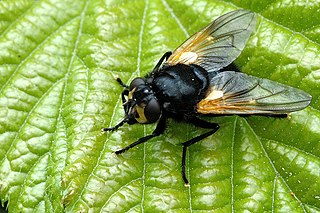
The American goldfinch is a small North American bird in the finch family. It is migratory, ranging from mid-Alberta to North Carolina during the breeding season, and from just south of the Canada–United States border to Mexico during the winter.

The common myna or Indian myna, sometimes spelled mynah, is a bird in the family Sturnidae, native to Asia. An omnivorous open woodland bird with a strong territorial instinct, the common myna has adapted extremely well to urban environments.

Nyctanthes arbor-tristis is a species of Nyctanthes native to South Asia and Southeast Asia. It is commonly known as night-blooming jasmine, tree of sadness, tree of sorrow, hengra bubar, coral jasmine, as seri gading in Singapore and as shiuli in the Bengal region. Despite its common name, the species is not a "true jasmine" and not of the genus Jasminum.

Erynnis is a genus in the skippers butterfly family Hesperiidae, known as the duskywings. Erynnis is found in the Neotropical realm and across the Palearctic, but the highest species diversity is in the Nearctic. The genus was erected by Franz von Paula Schrank in 1801.
A flashforward is a scene that temporarily takes the narrative forward in time from the current point of the story in literature, film, television and other media. Flashforwards are often used to represent events expected, projected, or imagined to occur in the future. They may also reveal significant parts of the story that have not yet occurred, but soon will in greater detail. It is similar to foreshadowing, in which future events are not shown but rather implicitly hinted at. It is also similar to an ellipsis, which takes the narrative forward and is intended to skim over boring or uninteresting details, for example the aging of a character. It is primarily a postmodern narrative device, named by analogy to the more traditional flashback, which reveals events that occurred in the past.

Eugeissona is a clustering genus of flowering plant in the palm family native to Borneo, Thailand and Malaysia. The six monoecious species provide a wide range of local uses and are commonly called bertam or wild Bornean sago. The genus is the sole representative of the Eugeissoninae having very few obvious relatives; the hermaphrodite and staminate flowers are also found in Metroxylon, however the other specialized characteristics are unique suggesting an early split and differentiation from other members of the Calameae. Fossilized pollen belonging to these plants has been recovered in the lower and middle Miocene deposits in Sarawak. The name is from two Greek words meaning "good" and "roof", due to their common use in roof thatching.

Mesembrina is a genus from the fly family Muscidae.

The black-headed monitor or black-tailed monitor is a relatively small species of monitor lizards native to Australia. It is occasionally also called the mournful monitor, freckled monitor or the racehorse monitor, a name it shares with the Gould's monitor due to their exceptional speed. It is placed in the subgenus Odatria.

Hoshihananomia is a genus of tumbling flower beetles in the family Mordellidae. There are at least 40 described species in Hoshihananomia.

Prolepsis is an insect genus of mainly neotropical Diptera in the family Asilidae or robber flies.

Herophila tristis is a species of beetle in the family Cerambycidae, they are also called longhorned beetles. It was described by Carl Linnaeus in 1767, originally under the genus Cerambyx. It is known from Italy, Romania, Austria, Bulgaria, Crete, Croatia, Sardinia, France, Greece, Serbia, Corsica, Sicily, Hungary, Slovenia, Albania, and Turkey. It feeds on Morus alba, Ficus carica, and Robinia pseudoacacia. They live 2–3 years and are 13–26 mm long. Larvae feed under the bark of a range of broad-leaved trees, mostly Ficus carica commonly known as fig trees. As an adult they hide in the day and come out in the dusk.
Serica tristis is a species of May beetle or junebug in the family Scarabaeidae. It is found in North America.
Peritrechus tristis is a species of dirt-colored seed bug in the family Rhyparochromidae. It is found in North America.

Epiphanis is a genus of false click beetles in the family Eucnemidae. There are at least two described species in Epiphanis.
Eulonchus tristis is a species of small-headed flies in the family Acroceridae.
Cryptorhynchus tristis is a species of hidden snout weevil in the beetle family Curculionidae. It is found in North America.

Erynnis tristis, commonly known as the mournful duskywing, is a species of spread-wing skipper in the butterfly family Hesperiidae. It is found in Central America, North America, and South America. It is mottled brown with a white fringe on the hind wings. It appears similar to the funereal duskywing, but the mournful duskywing is more likely to appear in urban areas. The larva feeds on young oaks while adults nectar from a variety of wild and garden flowers.
Brachypnoea tristis is a species of leaf beetle. It is found in the Eastern United States.
Diplotaxis tristis is a species of scarab beetle in the family Scarabaeidae. It is found in North America.













